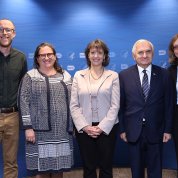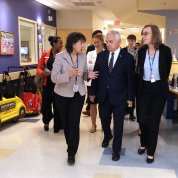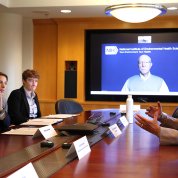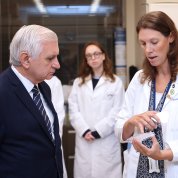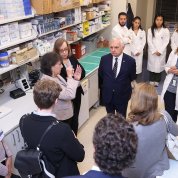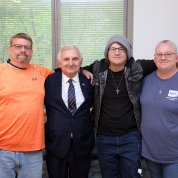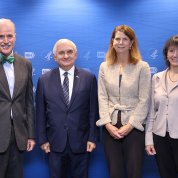Senator Reed Visits NIH, Explores Opportunities for Collaboration
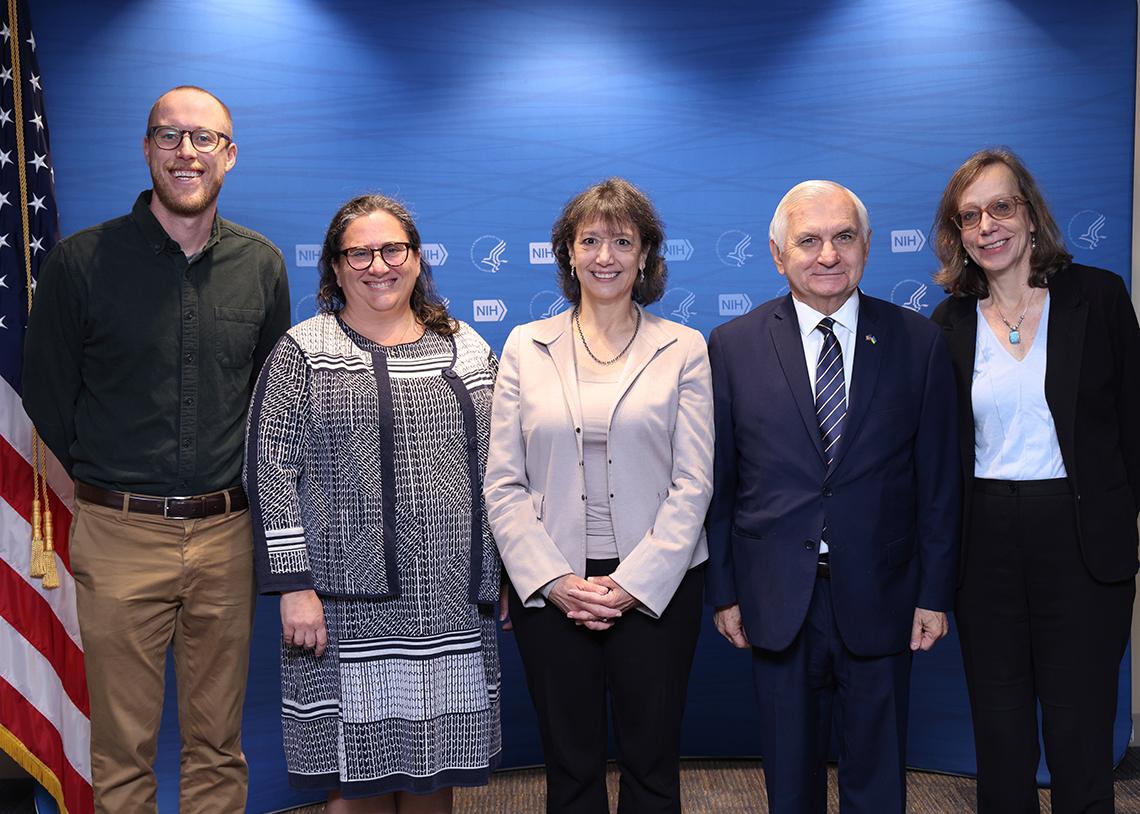
Photo: Chia-Chi Charlie Chang
Sen. Jack Reed (D-RI) visited NIH in September to discuss data challenges, the promise of RNA and global health. He spent the morning engaged in candid discussions with NIH Director Dr. Monica Bertagnolli and other NIH leaders at the Clinical Center, where he also toured a pediatric oncology lab and met with a young cancer patient.
A theme throughout the morning was how to bolster data collection, access and standards.
“Data is the fuel of every new technology,” said Reed, chairman of the Senate Armed Services Committee and a senior member of the House Appropriations Subcommittee that funds NIH. “We want to be part of the solution.”
Bertagnolli concurred on the importance of public-private partnerships while noting a major challenge in data access. Companies “are proprietary in ways that hurt our ability to amass and understand the data,” she said. “Our solution is: innovate on what you do with the data; don’t innovate on access to the data.”
The two discussed specific ideas and potential partnerships to help upgrade data sharing, access and security. In this all-of-government endeavor, Bertagnolli said, “We bring the research arm to it.” She and colleagues reiterated that diversity in clinical trials is imperative to ensuring data is robust and reliable.
Bertagnolli and Reed also discussed the potential of artificial intelligence (AI) in scientific applications. She said, “NIH must be a big part of the conversation on real applications and the future of where we hope it can go.”
Reading RNA
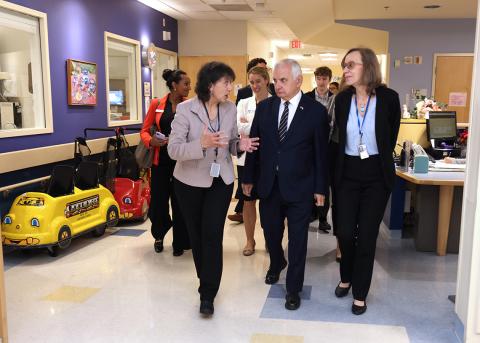
Photo: Chia-Chi Charlie Chang
NIH leaders described a recommendation in a recent National Academies report that has the potential to have a transformative effect on health—the effort to characterize all Ribonucleic Acid (RNA), referred to as the RNome project.
“The Human Genome Project gave us the alphabet,” Bertagnolli told Reed. “With RNA, we’re going to learn how to read it.”
“The genome comes alive when you analyze RNA,” said Dr. Rick Woychik, director, National Institute of Environmental Health Sciences, who spoke via Zoom. “Going in now and characterizing all of the different RNA molecules that can arise from stretches of DNA across the entire genome is the logical next step.”
Dr. Carolyn Hutter noted the timeliness of this research. “RNA has been around for a very long time, but I think interest is swelling now because there’s a convergence of technology and data advances, where this is the time to do it,” said Hutter, then-director, Division of Genome Sciences at the National Human Genome Research Institute.
“We want to be out in front of all of this and we can be with your help,” Woychik told Reed. “We need large data repositories collecting the information systematically that we can apply in innovative ways,” which would include the use of the emerging new AI strategies to study how these RNA molecules work within the cell, Woychik explained.
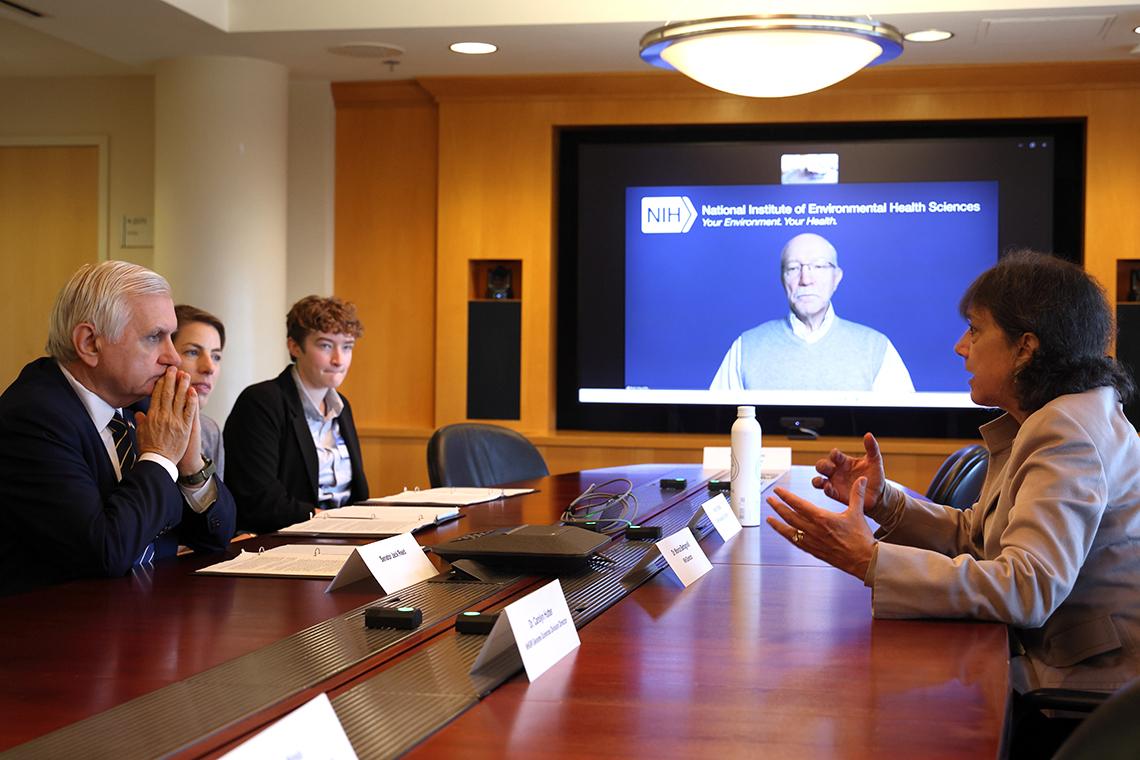
Photo: Chia-Chi Charlie Chang
“We’re also discovering environmental perturbations that can be influencing the production and modifications of RNA,” he continued. His institute is working with colleagues across NIH to study and address the totality of environmental influences—pollution, heat, micro/nanoplastics—collectively often referred to as the exposome—on human biology.
As one concerning example, Reed noted that large amounts of nanoplastics are found in the top two inches of the floor of Narragansett Bay, posing a range of potential health threats to those fishing and swimming in those waters.
That’s an example of why this research is so critical, Reed said. “When people wake up and discover a whole world is polluted by plastics and they have a health threat potentially,” he said, “then we better [pay attention] to RNA.”
Studying Sarcoma
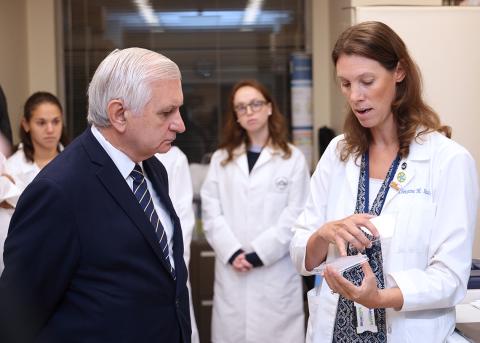
Photo: Chia-Chi Charlie Chang
Reed visited a pediatric oncology lab, where he met with Dr. Christine Heske, a National Cancer Institute (NCI) investigator who did her residency at Brown University, in the senator’s home state. She discussed sarcoma—a rare, intractable cancer that originates in connective tissues such as bone or muscle.
Many patients with sarcomas have poor outcomes with existing treatments. They may initially respond well but then relapse with difficult-to-control disease. Unfortunately, very few drugs have been developed for patients with sarcoma. Moreover, few experimental drugs wind up making it through clinical trials and it’s especially challenging to implement clinical trials for children with rare cancers, such as these.
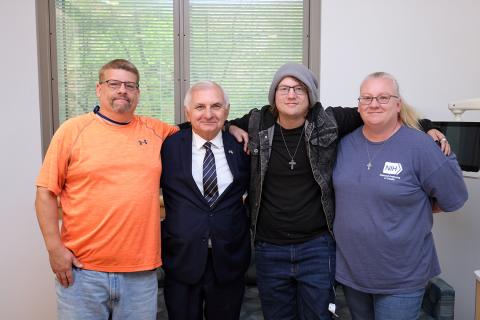
Photo: Chia-Chi Charlie Chang
Heske then shared a hopeful story. NCI researchers tested an experimental drug in cell lines and mouse models of pediatric sarcoma. In the mice, they treated them just twice and then stopped treatment. The result was promising.
“At six months out, none of the mice had recurrence of tumor,” she said. “This was dramatic and shocking for us because we almost never see this in animal models,” she said, also showing Reed data plotted over time from sarcoma cell cultures using an IncuCyte, an instrument that lets researchers see what cells are doing in real-time as they apply different treatments.
A first-in-human clinical trial was run at NCI in adult patients with any solid tumors and the sponsoring company agreed to sponsor a follow-up trial for adolescents and young adults with sarcoma. But when the company went bankrupt, the trial was suspended. To circumvent this challenge, Heske worked tirelessly for almost two years with NCI leaders, patient advocates and the Food & Drug Administration to get access to this experimental drug and begin this NIH-sponsored trial, which is expected to start enrolling patients shortly.
A Healthy World
The senator also met with Fogarty International Center (FIC) leadership to discuss support for global health, which has ripple effects here at home. With globalization comes disease spread—as the recent Covid pandemic starkly illustrated—and the need for preemptive action.

Photo: Chia-Chi Charlie Chang
FIC Director Dr. Kathleen Neuzil cited the current mpox outbreak as an example of the urgent need to act. Currently, Neuzil leads the mpox vaccine working group for the World Health Organization’s immunization advisory group.
“But if we just react to [a viral outbreak], it’s going to happen again and again,” she said, underscoring the importance of medium and long-term investments in scientific training and capacity-building.
“Know that Fogarty-trained scientists are at the forefront of the leadership in Africa,” Neuzil said, “and they’re at the forefront of response for Covid…Fogarty’s investments from 10 to 15 years ago are paying off today.”
In fact, FIC Deputy Director Dr. Peter Kilmarx told Reed, “When you’re traveling abroad, there’s probably an NIH collaboration or grantee in any place that you’re going. Reach out if we can be a resource during your travels.”
The discussion also touched on point-of-care (POC) technology opportunities to get resources to rural communities. Bertagnolli referenced a recent effort to help combat a syphilis outbreak in Native American communities in the U.S. Patients received test kits by mail and, after sending test results over their cell phones, received medicine by mail. Such POC efforts could improve outreach in communities across the world.
Beyond infectious disease outbreaks, FIC continues to enhance partnerships in other areas. For example, earlier that week, FIC leaders visited Walter Reed Institute for Research, which has labs throughout the world, to discuss collaborations on trauma and antimicrobial resistance research.
Reed agreed there’s a critical need to do more in these areas and asked for more related data to drive home this urgency in the Senate.
In the end, Reed and Bertagnolli said they’d maintain this dialogue on the vital issues discussed that day. “This is the future,” Reed said. Bertagnolli responded, “There’s never been a time like this for many reasons—for good, hopeful, exciting reasons.”

